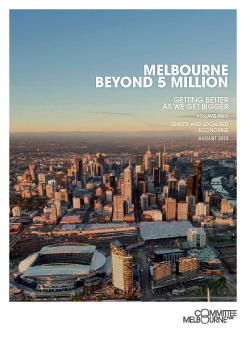
Melbourne Beyond 5 Million, Volume 2, Density and Localised Economies
[Source: Committee for Melbourne]
Density and Localised Economies, the second in a series of four volumes that define the outcome of the Committee for Melbourne’s 2010 Shaping Melbourne Taskforce, has been released.
Volume One of this series explored the importance of appropriate governance and effective decision making for the cities future. This included a broadly articulated long-term vision for how Melbourne could best benefit from addressing issues of physical shape, population, development, growth and regional relations.
Volume Two explores the issue of density and discusses the value of both creating new localised economies and reinforcing those that already exist. The report begins by covering population projections, rates of growth and demographic changes. This is followed by a review of Melbourne’s density and an overview of issues associated with viability. The relationship between planning and the market is presented along with a number of growth options. After discussing the role of regional cities, the report concludes with a series of actions to deliver change.
One of the clear issues emerging from the document is the current ‘policy void’ in both existing planning documents:
“Melbourne @ 5 million aspires to accommodate an additional half a million people within the established areas of Melbourne. It places a priority over designated activity areas across the metropolitan area and locations close to existing transport routes. Unfortunately, though, it provides no solution about the scale of development that may be expected, the planning regime that will implement the policy, the role of local municipalities and how local communities will have a voice. The situation is only exacerbated when the state chooses to override planning norms in the name of expediting projects.”
And in an overarching approach for the city’s future development:
“There is also a lack of a strong policy framework as to the preferred physical shape and form of Melbourne. If this ‘policy void’ continues, it is possible that increases in density will happen indiscriminately, with no strategic policies to determine how increased density will link to the provision of transport and other infrastructure. While the State Government has undertaken significant assessments of the capacity of metropolitan Melbourne to accommodate a population of five million, there is currently no plan that demonstrates how aspirations of new and existing communities and densification will actually be converted to reality – let alone for a population significantly beyond five million.”